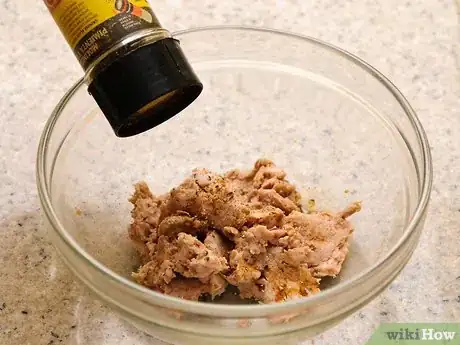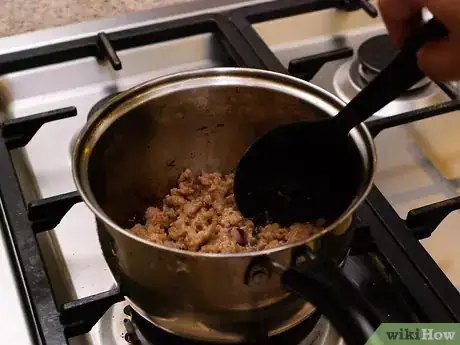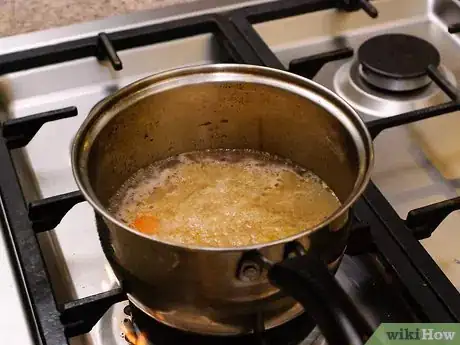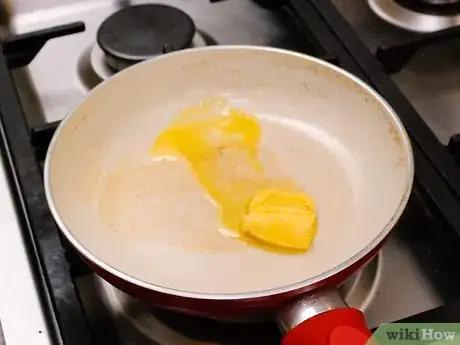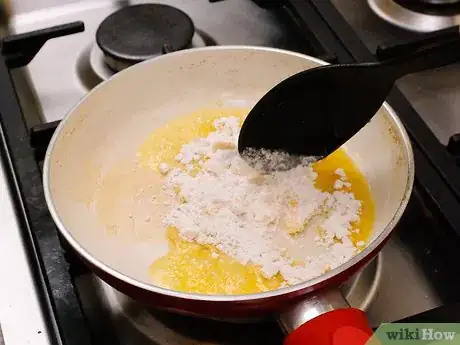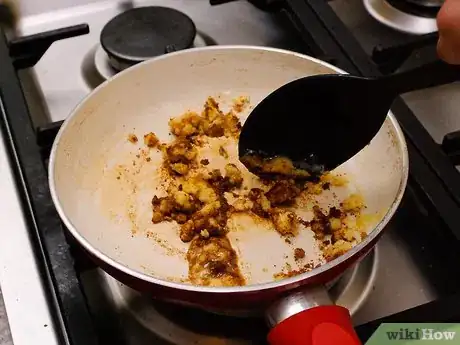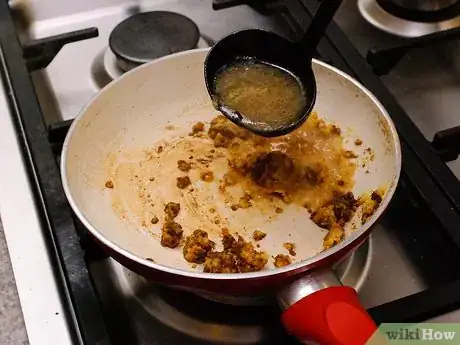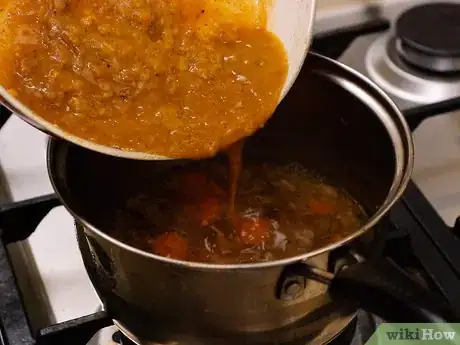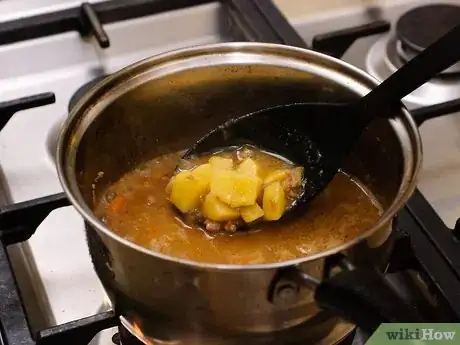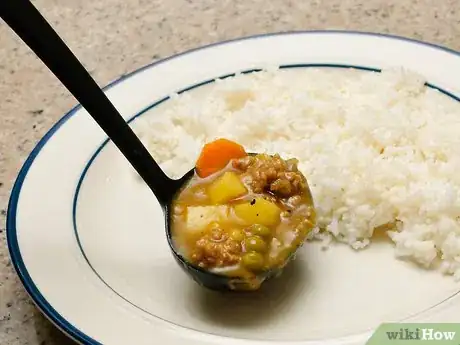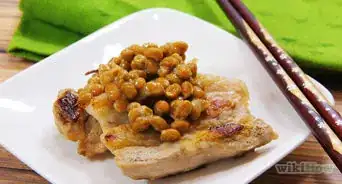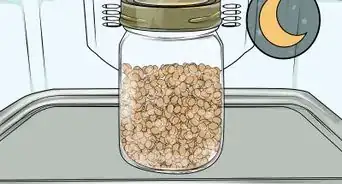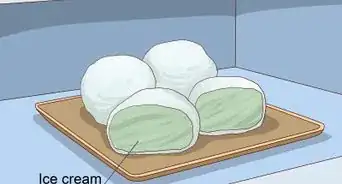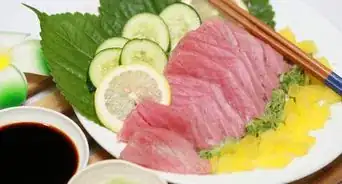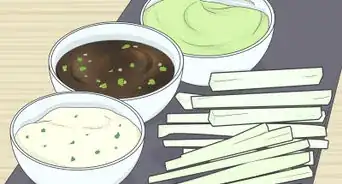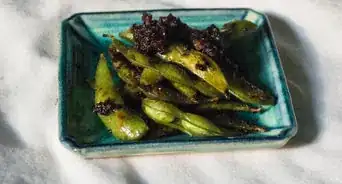wikiHow is a “wiki,” similar to Wikipedia, which means that many of our articles are co-written by multiple authors. To create this article, volunteer authors worked to edit and improve it over time.
This article has been viewed 36,669 times.
Learn more...
Japanese curry can be made in a few different ways, but in general, the dish is prepared by mixing a curry roux into a base of meat, vegetables, and seasoned liquid. The entire thing is then slow-cooked over low heat and served with a side of rice.
Ingredients
Makes 3 to 4 servings
- 4 Tbsp (60 ml) butter
- 7 Tbsp (105 ml) flour
- 2 Tbsp (30 ml) curry powder
- 2 Tbsp (30 ml) garam masala
- 1 lb (450 g) beef, pork, or chicken, cut into bite-sized chunks
- Salt and pepper, to taste
- 1 Tbsp (15 ml) vegetable oil
- 3 Tbsp (45 ml) ketchup
- 3 cups (750 ml) water
- 1 large onion, peeled and roughly chopped
- 3 carrots, peeled and cut into coins
- 1 small apple, peeled and grated
- 1 large potato, peeled and cut into small chunks
- 1 cup (250 ml) fresh or frozen edamame, shells removed
- Steamed rice
- Fukujinzuke
- Rakkyo
Steps
Preparing the Curry Base
-
1Season the meat. Sprinkle the meat with 1/2 tsp (2.5 ml) salt and 1/4 tsp (1.25 ml) ground black pepper, or season to taste. Set aside.
- If the meat is in one large chunk, cut it into 1-inch (2.5-cm) cubes before seasoning it. You may also want to pat it dry with clean paper towels, as well.
- Curry can be prepared in the same way no matter which meat you choose (solid beef, pork, or chicken), but you might want to vary the spices according to your own personal tastes. For instance, many prefer to add more heat when preparing pork curry. You can do so by increasing the amount of pepper you use or by sprinkling chili pepper powder into the curry base before you prepare the roux.
- If you decide to make chicken curry, opt for dark meat portions of chicken, like the thigh. Take the skin off before you add the chicken to the stockpot.
- Alternatively, you can skip the meat altogether and prepare a vegetarian curry by following the rest of the steps as described.
-
2Heat the oil. Pour the cooking oil into a large, heavy stockpot and heat it on medium over the stove. Give it a minute or so to warm up adequately.
- Note that you must use a heavy-bottomed stockpot with thick walls to avoid burning the curry. The stockpot should also be large enough to hold 5 L (5 qts).
- For a slightly richer taste, use butter or ghee instead of oil. Ultimately, however, the difference in taste might be difficult to distinguish since the flavor of the curry tends to overwhelm any subtle variations like this.
Advertisement -
3Add the onion. Place the chopped onion in the hot oil and cook for roughly 5 minutes, stirring frequently, or until soft and translucent. Temporarily remove them from the stockpot and place them on a nearby plate.
- If your stockpot is wide enough, you could just push the onion to one side instead of completely removing it. The important thing is to keep the cooked onion out of the way as you cook the meat.
-
4Stir in the meat. Add the meat to the stockpot. Let the pieces cook on one side for 1 to 3 minutes, or until browned on that side. Afterward, continue cooking for another 5 to 7 minutes, or until all sides have browned.
- Browning the meat ultimately adds more flavor to each bite.
- If you decided to leave the onions in the stockpot as you cook the meat, keep a close eye on them while the meat cooks. The onions can begin to brown and still taste fine, but if they shift from a dark tan to a dark brown, remove them immediately before they burn and blacken.
-
5Add most of the remaining base ingredients. Return the onions to the stockpot. At this time, you should also add the ketchup, water, carrots, and grated apple. Mix well to combine.
- Note that the only curry base ingredients you do not want to add at this time are the potatoes and edamame.
-
6Simmer for 20 minutes. Reduce the heat to medium-low or low, until the liquid is just barely simmering. Cook, uncovered, for 20 minutes. Stir the mixture occasionally to prevent anything from sticking or burning.
- As the curry base simmers, you should start preparing the roux.
Making the Curry Roux
-
1Melt the butter in a separate skillet. Add the butter to a small skillet. Heat over medium on the stove, stirring occasionally, until the butter has completely melted.
- To save time, you can skip over the instructions for making your own curry roux and use premade commercial curry cubes, instead. You will need about 4 cubes, or 3.5 oz (100 g), to match the amount of curry roux used in this recipe. Add them to the curry when you would usually add the homemade roux.[1]
- Do not melt the butter on a higher heat setting. Butter has a tendency to flash-boil once it reaches its smoking point. If you allow this to happen, you could cause the hot sizzling butter the splatter. The fat in the butter may also begin to break down, thereby affecting the flavor of the curry roux.
-
2Add the flour. Sprinkle the flour into the melted butter. Quickly stir it into the butter and continue cooking for 15 to 20 minutes, or until the roux turns a deep tan color.
- You must stir the roux constantly as it cooks, at least until the butter and flour fuse together and begin to swell. After that point, continue to stir the roux frequently.
- If you fail to stir the roux enough, it will burn quite quickly and develop a bad taste.
- The flour must be allowed to cook thoroughly in this manner. If you do not cook the flour enough, it will retain a strong starchy taste.
-
3Add the spices. Sprinkle the curry powder and garam masala into the roux. Stir the ingredients into the roux over the heat for about 30 seconds. Remove the roux from the heat as soon as the roux is seasoned.
- You'll know that the spices have mixed into the roux once they release a strong aroma.
-
4Ladle cooking liquid into the roux. Remove roughly 1/2 to 1 cup (125 to 250 ml) of the cooking liquid from the curry base. Rapidly stir this liquid into the roux until a paste forms.
- Add a little of the liquid first and mix it in gradually. You only want to use the minimum amount necessary to form a paste. If you add too much at once, combining the liquid with the roux might become difficult.
Finishing with Garnishes and Side Dishes
-
1Transfer the roux into the base. Stir well to combine the roux paste with the liquid in the stockpot.
- If you are adding commercial curry cubes instead of homemade curry cubes, add them now. Break up the blocks into smaller portions. Temporarily remove the pot from the heat and add the cubes into the liquid, stirring well until completely melted.
-
2Toss the potato in and simmer. Add the peeled and chopped potato into the stockpot and stir to distribute it evenly. Continue to simmer the curry on low heat for 1 hour, or until the meat and potatoes become tender and the curry liquid is very thick.
- Use the full 1 hour if making beef or pork curry. If making chicken curry, you should only let it simmer for 30 to 45 minutes to prevent the chicken from overcooking and drying out.
-
3Mix in the edamame. If you choose to add edamame, mix them in during the last 5 minutes of the cooking process.[2]
- You could add green peas to the curry if edamame is not available, or you could skip this part altogether.
- Make sure that the edamame have been removed from their shells before you add them into the curry.
-
4Serve. Ladle the curry into individual serving dishes. Serve it with a side of steamed white or brown rice. If desired, garnish with chopped fukujinzuke or rakkyou.
- Traditionally, Japanese curry is served in one of two ways: you can put the curry in a sauce boat and serve it with a separate dish of rice on the side, or you can put the rice on the plate and cover half of it with curry.[3]
- Note that fukujinzuke is a sweet mixture of pickled vegetables and rakkyou are small pickled shallots.
- You can store extra curry by freezing it, if desired, but you should prepare the curry without potatoes if you intend to so do. Potatoes that are frozen and later thawed have a tendency to turn into unappetizing mush. Boil the potatoes separately and add them to the frozen curry after you reheat it.
- To freeze curry, ladle a serving's worth into a freezer-safe resealable plastic bag. Label the bag with its contents and the current date. Repeat with the rest of the curry, preparing a separate bag for each individual serving.
-
5Finished.
Community Q&A
-
QuestionHow long will it take to make?
 MicheleTop AnswererTotal time will take anywhere from 1 - 2 hours. Prepping the onion and meat will take about 5 - 10 minutes or less, then you'll simmer the base for 20 minutes. Add 30 minutes to one hour for final simmer and to cook the potatoes, and there you go.
MicheleTop AnswererTotal time will take anywhere from 1 - 2 hours. Prepping the onion and meat will take about 5 - 10 minutes or less, then you'll simmer the base for 20 minutes. Add 30 minutes to one hour for final simmer and to cook the potatoes, and there you go. -
QuestionWhat if I don't have edamame?
 PimemorizedTop AnswererYou don't have to use edamame in your Japanese Curry. You can add other vegetables if you would like. If you want something close to edamame, try lima beans or green peas.
PimemorizedTop AnswererYou don't have to use edamame in your Japanese Curry. You can add other vegetables if you would like. If you want something close to edamame, try lima beans or green peas.
Things You'll Need
- Plate
- Sharp kitchen knife
- 5-L (5-qt) heavy stockpot
- Heat-resistant spatulas or mixing spoons
- Small skillet
- Ladle or serving spoon
- Individual serving dishes
- Freezer-safe plastic bags (for storage only)
References
About This Article
To make a Japanese curry, start by seasoning the meat with salt and pepper. Then, fry an onion in vegetable oil for 5 minutes and brown the meat. Next, add ketchup, water, grated apple, and carrots, and simmer the mixture for 20 minutes. In a separate pot, make a roux with melted butter and flour, and mix in 1 cup of the cooking liquid to make a paste. Afterwards, mix the paste into the curry, then add potatoes and cook for 1 hour. For tips on how to add edamame to your curry, read on!
